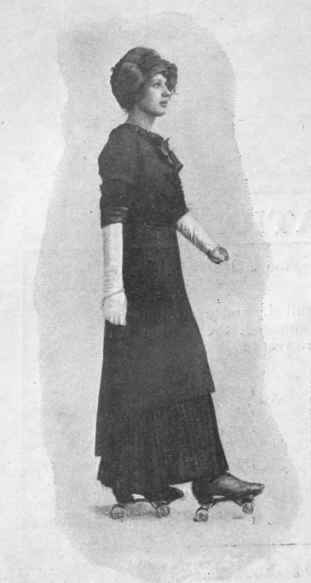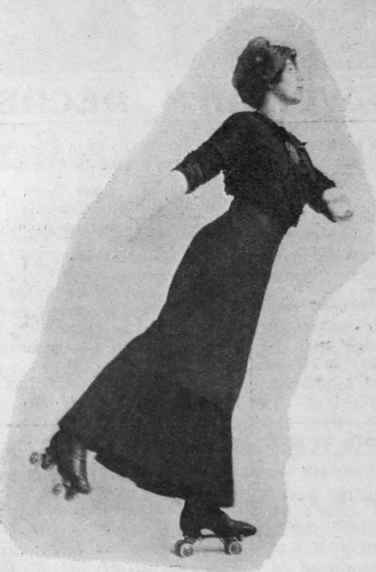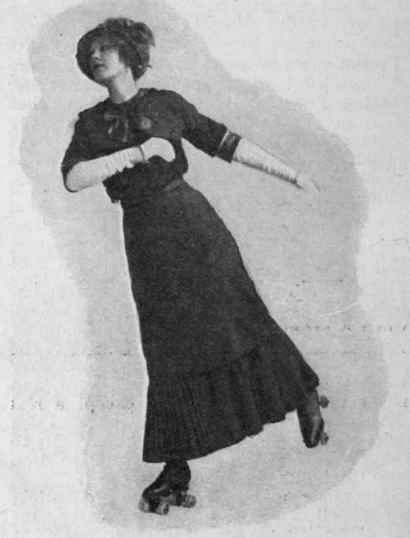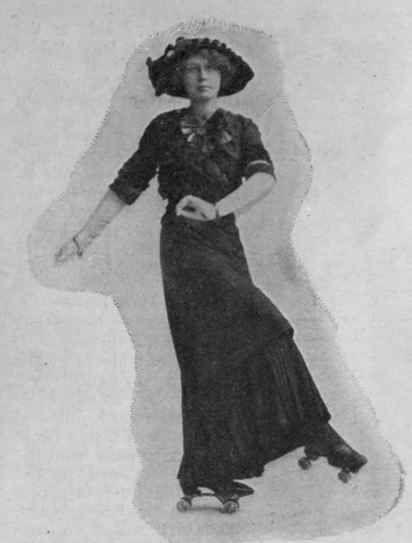The Graceful Art Of Roller Skating
Description
This section is from "Every Woman's Encyclopaedia". Also available from Amazon: Every Woman's Encyclopaedia.
The Graceful Art Of Roller Skating
This is the first of a series of articles by Miss Gladys Ingram, one of the best-known and most 'proficient lady roller skaters of the day. Miss Ingram was a pupil of the famous toller skater, Professor Lewis, of Brighton, and in the opinion of Mr.r.k.bartlett, late floor manager of Olympia, London, who has initiated thousands of enthusiasts in his art, she is the greatest stylist and most graceful roller skater he has ever seen. The lesson she gives here on how to learn the art of roller skating should therefore be read with particular interest
There are few more fascinating or more healthful winter pastimes than roller skating. Fortunately, too, the art is one that is by no means difficult to acquire if only beginners in their " apprenticeship " days would really take reasonable precautions to avoid those bad habits which, when once acquired, are so very difficult to break.
"English" and "International" Skating
The great question, therefore, to consider first is how to avoid getting into a bad style. The natural answer is that it is almost impossible to avoid acquiring bad habits unless, when a beginner, you place yourself under " the sole tuition of a first-class master of the art. Having done this, all that is necessary to obtain proficiency is to work hard, and never to skate with anyone except a real master of the art of roller skating until you have reached a sufficiently perfected state to make it almost impossible for you to drop into the faults of others.
Here let me say that there are two distinct recognised styles of roller skating - the " English" and the " International." It will not be necessary, however, for me to refer here to the former style as, fortunately, it is rapidly dying a natural death, the majority of roller skaters having at last realised that it is stiff and ungraceful.
I will confine myself entirely, therefore, to the " International " style, which comprises not only the most perfect execution of the actual figures themselves, but also the most attractive carriage of the body, combining two qualifications particularly desirable on wheels - dignity and grace. Indeed, one would be almost justified in describing the finest " International " skating as the perfection of stage dancing on skates.
The Importance Of Style
Before dealing with the best methods of learning, which I might call the A B C movements of roller skating, I should like to say that it has always struck me that the highest art lies in perfection of style. And I am inclined to think that style is " everything.'
To those who really understand roller skating the mere performance of weird and difficult-looking figures conveys nothing. They are merely acrobatic feats, which may perhaps impress a crowd ignorant of the real art of roller skating, but which, to the true expert, are so much waste of effort, in that they have absolutely nothing to do with first-class skating.

Walking round the rink. Showing heel down first
Many readers of Every Woman's Encyclopaedia must, at some time or another, have noticed a large number of people surrounding a skater on some public rink, watching him or her perform some difficult feat of a more or less acrobatic nature. Suddenly some new skater has appeared upon the scene, and, without having done anything more than a few simple edges, has nevertheless attracted the attention of almost everyone on the rink, and caused the acrobatic person to be left alone.
Using The Body
Why has the newcomer suddenly become the centre of attraction ? I can answer the query in one word - "Style."
It has often struck me that a large number of skaters appear to be under the extraordinary, and utterly erroneous, impression that on rollers one only skates with one's legs and feet. As a matter of fact, such is not the case at all, for the-shoulders, head, arms, and hands, perform a most important function in both the style and execution of well-taught International roller skating.
And yet I have seen hundreds of men and women who have " passed " among their friends as quite good skaters, who have nevertheless literally " murdered " the art, skating with their hands to their sides, after the manner of a soldier standing to attention on parade, and holding their bodies so stiffly that they have conveyed the impression of being paralysed from the hips upwards.
Again, scores of skaters who are commonly supposed to be quite proficient performers are quite unable to skate in a straight line in a proper manner. Why is this ? Simply because they have been badly taught in their early lessons, and have acquired the fatal habit of striking out from side to side.
I trust it will not be thought that I have devoted too much space to the fault s which are most prevalent on rollers. I scarcely think, however, that I can be justly accused of having done so, for it is these faults which so effectually mar the efforts of many roller skaters, who, if they had only put themselves in the right hands when first taking to roller skating, might have become really expert performers.

Toward outside edge

Inside forward edge. First position. The right arm is held a little too high

Second position of the inside forward eight
And now for a first lesson on wheels. The initial thing to learn is to walk round properly. This is best done by taking small steps, and by putting the heel down first, bending the knee and straightening it again, at the same time taking care never to strike out from side to side, and also never to dream of going on a rink if you happen to be wearing high heels. High heels, I must tell you, have spoilt the chances of attaining proficiency of many an enthusiastic wheelist.
Continue to:


